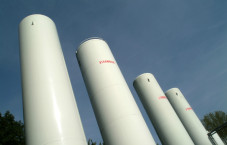Cooling with liquid CO₂- or N₂-injection
 During some of the production processes in the food industry, heat is released which is not desirable for the quality of the food. To be able to keep the temperature low enough, liquid CO2 is used as coolant.
During some of the production processes in the food industry, heat is released which is not desirable for the quality of the food. To be able to keep the temperature low enough, liquid CO2 is used as coolant.
Application scope
When kneading dough in industrial bakeries, heat is released during the kneading. When the temperature in the dough rises too much, there is a risk that the yeast starts to work too early during the kneading, instead of in the rising chamber. An injection of liquid carbon dioxide (CO2) above the kneader will ensure that a fine snow of CO2 lands in the dough and as such can cool the dough down to the desired temperature.
With the cutting of meat to mince in a meat cutter, unwanted heat is also released, which is created by the mechanical movement of the knives. This heat will result in the meat partially cooking at some points, which is of course not the intention. To avoid this, one can make use of liquid CO2 as cooling medium. In this application one can also inject nitrogen (N2).
Installing and working principle
The applications where liquid CO2 is used for cooling purposes in the food industry are always based on its physical characteristics, whereby during the expansion of liquid CO2, a fixed and a gaseous aggregation condition arise. The solid part, also known as CO2-snow, has a temperature of -79°C and provides cooling. The gaseous part will typically have a temperature between -50°C and -60°C and is evacuated from the space via an extraction pipe.
A typical installation will consist of the following parts:
- Cryogenic storage tank with a capacity that is tuned to the predicted consumption, optionally fitted with a telemetry device to keep track of the content and pressure of the tank, as well as to initiate the deliveries automatically.
- Vacuum insulated pipe to be able for the liquid CO2 to reach the user with as little loss of temperature as possible.
- Injection device through which the CO2 can be dosed, whether or not integrated in the available automation systems.
- The gas suction to be extracted to the outside air.
- CO2-detection to check the space for too high concentrations.
Delivery possibilities
For this application, IJsfabriek Strombeek can provide mini bulk containers during a pilot project so that we can assist you to make the right choice and to assess the impact on the process. Once this stage is implemented one always works with a storage tank and bulk deliveries.

